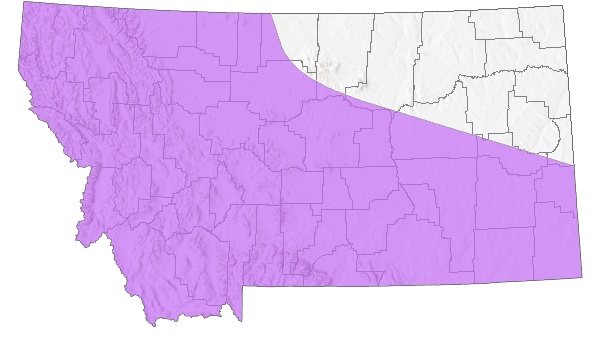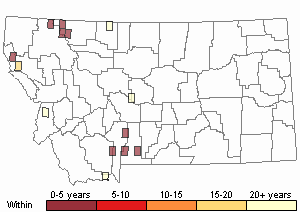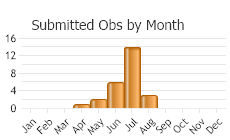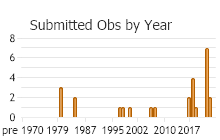View in other NatureServe Network Field Guides
NatureServe
Montana
Utah
Wyoming
Idaho
Wisconsin
British Columbia
South Carolina
Yukon
California
New York
Margined White - Pieris marginalis
Native Species
Global Rank:
G5
State Rank:
S5
Agency Status
USFWS:
USFS:
BLM:
External Links
General Description
[From Ferris and Brown 1981; Scott 1986; Opler and Wright 1999; Glassberg 2001; Pyle 2002] Forewing 2.0-2.5 cm. White overall, forewing somewhat pointed. Uppersurface immaculate white to heavily dusted with black, black scaling concentrated along wing veins, nearly absent in cells between veins. Male sometimes with a single round black spot in discal cell of forewing, female sometimes with two black spots (one in discal cell, one near trailing edge of wing more diffuse). Undersurface nearly immaculate white to yellow-tinged, heavily marked with gray-green along veins.
Phenology
One flight, mostly June in Alaska and in the Rocky Mountain states; two or three flights elsewhere, February to mid-September (Scott 1986). June to mid-August in most of range, April to August in Arizona and New Mexico, mostly May to July in Pacific lowlands (Glassberg 2001). Early April to early October, depending on elevation in Colorado (Scott and Scott 1978), early March to early October in Oregon and Washington (Pyle 2002), early March to mid-September in Oregon (Warren 2005), late April to September in British Columbia (Threatful 1988; Guppy and Shepard 2001).
Diagnostic Characteristics
Best determined by a combination of uppersurface immaculate white to heavily dusted with black, black scaling concentrated along wing veins and nearly absent in cells between veins; undersurface nearly immaculate white to yellow-tinged, heavily marked with gray-green along veins .
Species Range
Montana Range
Range Descriptions

 Native
Native
Range Comments
Alaska panhandle and British Columbia south in the west to central California, east to southeastern Montana, western South Dakota and Nebraska, central Colorado, east-central Arizona, and southern New Mexico, with an isolated population in the Cypress Hills of Alberta/Saskatchewan; largely absent from southwestern deserts and arid lands (Scott 1986; Opler and Wright 1999; Glassberg 2001; Pyle 2002); 1310 m to 2743 m elevation in Colorado (Scott and Scott 1978), mostly 2743 m elevation to treeline in Colorado (Brown 1957), above 2135 m elevation in the central Rocky Mountains (Ferris and Brown 1981), sea level to over 1829 m elevation in Oregon (Warren 2005), to at least 2134 m elevation in Washington (James and Nunnallee 2011), 456 m to 1859 m elevation in southeastern British Columbia (Threatful 1988). In Montana, reported from all counties in the western 1/2 of the state, east to Custer County (Kohler 1980; Stanford and Opler 1993). Uncommon to common (Glassberg 2001).
Observations in Montana Natural Heritage Program Database
Number of Observations: 41
(Click on the following maps and charts to see full sized version)
Map Help and Descriptions
Relative Density

Recency



 (Observations spanning multiple months or years are excluded from time charts)
(Observations spanning multiple months or years are excluded from time charts)
Migration
Non-migratory; adults may move up to 5 km (Scott 1986).
Habitat
Moist woods and meadows, coniferous forest openings, along stream courses, roadsides, glens, seeps, tundra (Scott 1986; Opler and Wright 1999; Glassberg 2001; Pyle 2002). In Glacier National Park, Montana reported above treeline in alpine terrain (Debinski 1993); in the Greater Yellowstone Ecosystem reported in shady deciduous and conifer forest, forest clearings and edges, tundra, roadsides, and montane wet meadows (Debinski and Pritchard 2002; Debinski et al. 2013).
Food Habits
Larval food plants are native and exotic mustards, including Alyssum, Arabis, Armoracia, Barbarea, Brassica (multiple species), Cardamine (multiple species), Dentaria, Descurainia, Draba, Lepidium, Nasturtium, Raphanus, Rorippa, Sinapis, Sisymbrium, and Thlaspi (Scott 1986, 1992, 2006; Guppy and Shepard 2001; Graves and Shapiro 2003; James and Nunnallee 2011). Adults feed on flower nectar, including Achillea, Arnica, Arctium, Astragalus, Cardamine, Claytonia, Epilobium, Erigeron, Eriogonum, Fragaria, Geranium, Monarda, Oxypolis, Potentilla, Rubus, Senecio, Smilacina, Solidago, Symphyotrichum, and Taraxacum (Pyle 2002; James and Nunnallee 2011; Scott 2014).
Reproductive Characteristics
Females lay eggs singly, mostly on the undersides of host plant leaves, sometimes stems (Scott 1986, 1992, 2006; James and Nunnallee 2011). Number of eggs per ovariole (1/8 of total) about 90 (Ehrlich and Ehrlich 1978). Eggs hatch in about 4-5 days (depending on temperature), develop rapidly from L1 instar to L5 instar and pupae in about 18-21 days post egg-hatch, adults eclose (emerge from pupae) in about 8-10 days (Guppy and Shepard 2001; James and Nunnallee 2011). Larvae bore into leaves, feed also on flowers and fruits, build no nests, pupate on and off host plant; pupae hibernate (Scott 1979, 1986; Guppy and Shepard 2001; James and Nunnallee 2011). Males patrol throughout the day along trails, roads, shaded watercourses seeking females (Scott 1975b, 1986; James and Nunnallee 2011).
Stewardship Responsibility
References
- Literature Cited AboveLegend:
 View Online Publication
View Online Publication Brown, F.M. 1957. Colorado Butterflies. Proceedings; Numbers Three through Seven. Denver Museum of Natural History, Denver, Co.
Brown, F.M. 1957. Colorado Butterflies. Proceedings; Numbers Three through Seven. Denver Museum of Natural History, Denver, Co. Debinski, D. 1993. Butterflies of Glacier National Park, Montana. Occasional Papers of the Museum of Natural History, the University of Kansas, Lawrence, Kansas. No. 159: 1-13.
Debinski, D. 1993. Butterflies of Glacier National Park, Montana. Occasional Papers of the Museum of Natural History, the University of Kansas, Lawrence, Kansas. No. 159: 1-13. Debinski, D.M. and J.A. Pritchard. 2002. A field guide to the butterflies of the Greater Yellowstone Ecosystem. Lanham, MD: Roberts Rinehart Publishers. 107 p.
Debinski, D.M. and J.A. Pritchard. 2002. A field guide to the butterflies of the Greater Yellowstone Ecosystem. Lanham, MD: Roberts Rinehart Publishers. 107 p. Debinski, D.M., J.C. Caruthers, D. Cook, J. Crowley, and H. Wickham. 2013. Gradient-based habitat affinities predict species vulnerability to drought. Ecology 94(5): 1036-1045.
Debinski, D.M., J.C. Caruthers, D. Cook, J. Crowley, and H. Wickham. 2013. Gradient-based habitat affinities predict species vulnerability to drought. Ecology 94(5): 1036-1045. Ehrlich, A.H. and P.R. Ehrlich. 1978. Reproductive strategies in the butterflies: I. Mating frequency, plugging, and egg number. Journal of the Kansas Entomological Society 51(4): 666-697.
Ehrlich, A.H. and P.R. Ehrlich. 1978. Reproductive strategies in the butterflies: I. Mating frequency, plugging, and egg number. Journal of the Kansas Entomological Society 51(4): 666-697. Ferris, C.D. and F.M. Brown (eds). 1981. Butterflies of the Rocky Mountains. Univ. of Oklahoma Press. Norman. 442 pp.
Ferris, C.D. and F.M. Brown (eds). 1981. Butterflies of the Rocky Mountains. Univ. of Oklahoma Press. Norman. 442 pp. Glassberg, J. 2001. Butterflies through Binoculars: A Field Guide to the Butterflies of Western North America. Oxford University Press.
Glassberg, J. 2001. Butterflies through Binoculars: A Field Guide to the Butterflies of Western North America. Oxford University Press. Graves, S.D. and A.M. Shapiro. 2003.Exotics as host plants of the California butterfly fauna. Biological Conservation 110: 413-433.
Graves, S.D. and A.M. Shapiro. 2003.Exotics as host plants of the California butterfly fauna. Biological Conservation 110: 413-433. Guppy, C.S. and J.H. Shepard. 2001. Butterflies of British Columbia: including western Alberta, southern Yukon, the Alaska Panhandle, Washington, northern Oregon, northern Idaho, northwestern Montana. UBC Press (Vancouver, BC) and Royal British Columbia Museum (Victoria, BC). 414 pp.
Guppy, C.S. and J.H. Shepard. 2001. Butterflies of British Columbia: including western Alberta, southern Yukon, the Alaska Panhandle, Washington, northern Oregon, northern Idaho, northwestern Montana. UBC Press (Vancouver, BC) and Royal British Columbia Museum (Victoria, BC). 414 pp. James, D.G. and D. Nunnallee. 2011. Life histories of Cascadia butterflies. Corvallis, OR: Oregon State University Press. 447 p.
James, D.G. and D. Nunnallee. 2011. Life histories of Cascadia butterflies. Corvallis, OR: Oregon State University Press. 447 p. Kohler, S. 1980. Checklist of Montana Butterflies (Rhopalocera). Journal of the Lepidopterists' Society 34(1): 1-19.
Kohler, S. 1980. Checklist of Montana Butterflies (Rhopalocera). Journal of the Lepidopterists' Society 34(1): 1-19. Opler, P.A. and A.B. Wright. 1999. A field guide to western butterflies. Second edition. Peterson Field Guides. Houghton Mifflin Company, Boston, Massachusetts. 540 pp.
Opler, P.A. and A.B. Wright. 1999. A field guide to western butterflies. Second edition. Peterson Field Guides. Houghton Mifflin Company, Boston, Massachusetts. 540 pp. Pyle, R.M. 2002. The butterflies of Cascadia: a field guide to all the species of Washington, Oregon, and surrounding territories. Seattle Audubon Society, Seattle, Washington. 420 pp.
Pyle, R.M. 2002. The butterflies of Cascadia: a field guide to all the species of Washington, Oregon, and surrounding territories. Seattle Audubon Society, Seattle, Washington. 420 pp. Scott, J.A. 1975b. Mate-locating behavior of western North American butterflies. Journal of Research on the Lepidoptera 14:1-40.
Scott, J.A. 1975b. Mate-locating behavior of western North American butterflies. Journal of Research on the Lepidoptera 14:1-40. Scott, J.A. 1979. Hibernal diapause of North American Papilionoidea and Hesperioidea. Journal of Research on the Lepidoptera 18(3): 171-200.
Scott, J.A. 1979. Hibernal diapause of North American Papilionoidea and Hesperioidea. Journal of Research on the Lepidoptera 18(3): 171-200. Scott, J.A. 1986. The butterflies of North America: a natural history and field guide. Stanford University Press, Stanford, California.
Scott, J.A. 1986. The butterflies of North America: a natural history and field guide. Stanford University Press, Stanford, California. Scott, J.A. 1992. Hostplant records for butterflies and skippers (mostly from Colorado) 1959-1992, with new life histories and notes on oviposition, immatures, and ecology. Papilio new series #6. 185 p.
Scott, J.A. 1992. Hostplant records for butterflies and skippers (mostly from Colorado) 1959-1992, with new life histories and notes on oviposition, immatures, and ecology. Papilio new series #6. 185 p. Scott, J.A. 2006. Butterfly hostplant records, 1992-2005, with a treatise on the evolution of Erynnis, and a note on new terminology for mate-locating behavior. Papilio new series #14. 74 p.
Scott, J.A. 2006. Butterfly hostplant records, 1992-2005, with a treatise on the evolution of Erynnis, and a note on new terminology for mate-locating behavior. Papilio new series #14. 74 p. Scott, J.A. 2014. Lepidoptera of North America 13. Flower visitation by Colorado butterflies (40,615 records) with a review of the literature on pollination of Colorado plants and butterfly attraction (Lepidoptera: Hersperioidea and Papilionoidea). Contributions of the C.P. Gillette Museum of Arthopod Diversity. Fort Collins, CO: Colorado State University. 190 p.
Scott, J.A. 2014. Lepidoptera of North America 13. Flower visitation by Colorado butterflies (40,615 records) with a review of the literature on pollination of Colorado plants and butterfly attraction (Lepidoptera: Hersperioidea and Papilionoidea). Contributions of the C.P. Gillette Museum of Arthopod Diversity. Fort Collins, CO: Colorado State University. 190 p. Scott, J.A. and G.R. Scott. 1978. Ecology and distribution of the butterflies of southern central Colorado. Journal of Research on the Lepidoptera 17(2): 73-128.
Scott, J.A. and G.R. Scott. 1978. Ecology and distribution of the butterflies of southern central Colorado. Journal of Research on the Lepidoptera 17(2): 73-128. Stanford, R.E. and P.A. Opler. 1993. Atlas of western USA butterflies: including adjacent parts of Canada and Mexico. Unpubl. Report. Denver and Fort Collins, Colorado 275 pp.
Stanford, R.E. and P.A. Opler. 1993. Atlas of western USA butterflies: including adjacent parts of Canada and Mexico. Unpubl. Report. Denver and Fort Collins, Colorado 275 pp. Threatful, D.L. 1988. A list of the butterflies and skippers of Mount Revelstoke and Glacier National Parks, British Columbia, Canada (Lepidoptera). Journal of Research on the Lepidoptera 27(3-4): 213-221.
Threatful, D.L. 1988. A list of the butterflies and skippers of Mount Revelstoke and Glacier National Parks, British Columbia, Canada (Lepidoptera). Journal of Research on the Lepidoptera 27(3-4): 213-221. Warren, A.D. 2005. Lepidoptera of North America 6: Butterflies of Oregon, their taxonomy, distribution, and biology. Contributions of the C. P. Gillette Museum of Arthropod Diversity, Colorado State University. Fort Collins, Colorado. 406 pp.
Warren, A.D. 2005. Lepidoptera of North America 6: Butterflies of Oregon, their taxonomy, distribution, and biology. Contributions of the C. P. Gillette Museum of Arthropod Diversity, Colorado State University. Fort Collins, Colorado. 406 pp.
- Additional ReferencesLegend:
 View Online Publication
View Online Publication
Do you know of a citation we're missing? Allen, T.J., J.P. Brock, and J. Glassberg. 2005. Caterpillars in the field and garden: a field guide to the butterfly caterpillars of North America. Oxford University Press.
Allen, T.J., J.P. Brock, and J. Glassberg. 2005. Caterpillars in the field and garden: a field guide to the butterfly caterpillars of North America. Oxford University Press. Brock, J.P. and K. Kaufman. 2003. Kaufman Field Guide to Butterflies of North America. Houghton Mifflin Company, New York, NY 284 pp.
Brock, J.P. and K. Kaufman. 2003. Kaufman Field Guide to Butterflies of North America. Houghton Mifflin Company, New York, NY 284 pp. Caruthers, J.C., and D. Debinski. 2006. Montane meadow butterfly species distributions in the Greater Yellowstone Ecosystem. University of Wyoming National Park Service Research Center Annual Report, 2006. Vol. 30, Art. 14. 85-96.
Caruthers, J.C., and D. Debinski. 2006. Montane meadow butterfly species distributions in the Greater Yellowstone Ecosystem. University of Wyoming National Park Service Research Center Annual Report, 2006. Vol. 30, Art. 14. 85-96. Forister, M.L., C.A. Halsch, C.C. Nice, J.A. Fordyce, T.E. Dilts, J.C. Oliver, K.L. Prudic, A.M. Shapiro, J.K. Wilson, J. Glassberg. 2021. Fewer butterflies seen by community scientists across the warming and drying landscapes of the American West. Science 371:1042-1045.
Forister, M.L., C.A. Halsch, C.C. Nice, J.A. Fordyce, T.E. Dilts, J.C. Oliver, K.L. Prudic, A.M. Shapiro, J.K. Wilson, J. Glassberg. 2021. Fewer butterflies seen by community scientists across the warming and drying landscapes of the American West. Science 371:1042-1045. Layberry, R.A., P.W. Hall, and J.D. LaFontaine. 1998. The Butterflies of Canada. University of Toronto Press. 280 pp. + color plates.
Layberry, R.A., P.W. Hall, and J.D. LaFontaine. 1998. The Butterflies of Canada. University of Toronto Press. 280 pp. + color plates.
- Web Search Engines for Articles on "Margined White"
- Additional Sources of Information Related to "Insects"





